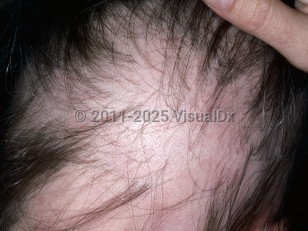- Bacterial thyroiditis (acute or chronic) – Rare and due to suppurative infection of the thyroid gland associated with an abscess. Most common in children and young adults with the presence of a piriform sinus. Immunosuppressed patients prone to bacteremia are also at risk. In the elderly, a long-standing goiter is a risk factor. Patients present with unilateral neck pain accompanied by fever and chills. Physical examination can reveal a fluctuant neck mass. Laboratory tests show elevated WBC with left-shift and C-reactive protein (CRP) and normal thyrotropin. Chronic infections present with less severe thyroid pain and can present with hypothyroidism. Ultrasound will show an abscess and fine-needle aspiration (FNA) can show granulomas with bacteria. Treatment is with intravenous antibiotics and abscess drainage. Surgical drainage might be needed in patients who do not respond to initial therapy
- Subacute or de Quervain thyroiditis – Often secondary to viral illness and may be mistaken for viral pharyngitis. Commonly implicated viruses include mumps, measles, rubella, influenza, SARS-CoV-2, coxsackie, adenoviruses, and echoviruses. Peak incidence occurs in ages 30-50 years with women more often affected than men. This is also associated with HLA-B35. Patients typically present with pain or a swelling sensation in the neck; pain may radiate to the jaw, throat, chest, and/or ears. It may be precipitated by an acute upper respiratory illness with fever. The thyroid is usually diffusely enlarged and tender to palpation. There are alterations in thyroid function over the course of the disease, initially with hyperthyroidism and increased T3 and T4 with depressed thyrotropin for several weeks, followed by subclinical hypothyroidism with decreased T3 and T4 with increased thyrotropin for several weeks, finally returning to euthyroid state as the disease subsides. In addition, erythrocyte sedimentation rate (ESR) can be elevated. Thyroid ultrasound will show a normal-to-enlarged thyroid. The diagnosis is based on clinical presentation, and treatment focuses around pain relief and symptom control for hyperthyroidism.
- Silent thyroiditis (painless thyroiditis, subacute lymphocytic thyroiditis) – Considered a variant of autoimmune thyroiditis (Hashimoto thyroiditis) and presents in a similar manner to subacute thyroiditis with a hyperthyroid phase, followed by a hypothyroid phase, and finally return to euthyroid. This entity is more common in women and often associated with type 1 diabetes mellitus and pregnancy. ESR values are typically normal and thyroid peroxidase (TPO) antibodies are present.
- Radiation thyroiditis – Develops in patients with Graves disease who have undergone treatment with radioiodine. Thyroid pain occurs several days later and is due to the radiation-induced injury and necrosis of thyroid follicular cells. This pain typically resolves in a few days.
- Drug-induced thyroiditis – Painless thyroiditis may be seen in patients receiving interleukin 2 (IL-2), interferon alfa, amiodarone, lithium, tyrosine kinase inhibitor, or checkpoint inhibitor immunotherapy.
- Postpartum thyroiditis – Similar to clinical presentation to silent thyroiditis. It occurs up to one year postpartum and can be associated with elevated serum antithyroid antibodies. It can present with transient hypothyroidism, hyperthyroidism, or both.
Thyroiditis
Alerts and Notices
Important News & Links
Synopsis

Codes
E06.9 – Thyroiditis, unspecified
SNOMEDCT:
82119001 – Thyroiditis
Look For
Subscription Required
Diagnostic Pearls
Subscription Required
Differential Diagnosis & Pitfalls

Subscription Required
Best Tests
Subscription Required
Management Pearls
Subscription Required
Therapy
Subscription Required
Drug Reaction Data
Subscription Required
References
Subscription Required
Last Updated:03/20/2024

